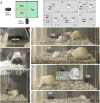Third-party punishment-like behavior in a rat model
- PMID: 39333120
- PMCID: PMC11436845
- DOI: 10.1038/s41598-024-71748-x
Third-party punishment-like behavior in a rat model
Erratum in
-
Publisher Correction: Third-party punishment-like behavior in a rat model.Sci Rep. 2024 Oct 22;14(1):24898. doi: 10.1038/s41598-024-76454-2. Sci Rep. 2024. PMID: 39438561 Free PMC article. No abstract available.
Abstract
Third-party punishment (TPP) is an altruistic behavior or sense willing to punish transgressors as a third party not directly involved in the transgression. TPP is observed worldwide, regardless of tradition and culture, and is essential for morality in human society. Moreover, even preverbal infants display TPP-like judgement, suggesting that TPP is evolutionarily conserved and innate. Thus, it is possible that non-human animals display TPP-like behavior, although TPP has been said to be human-specific. We investigated whether or not male mature Wistar rats displayed TPP-like behaviors when they witnessed deadly aggression by an unknown aggressive mouse toward another unknown victim mouse. Normally reared rats did not display TPP-like behaviors, but rats reared with extensive affectionate handling by human caretakers as beloved pets contacted the unknown aggressive mice in a gentle manner leading to reduced aggression toward the unknown victim mice, even when the aggressive mice fought back. Furthermore, the handled rats touched unknown rat pups that were drowning in water and anesthesia-induced comatose rats more frequently than control rats. These findings suggest a possibility that TPP is not in fact human-specific and innate but rather an acquired behavior that flourishes in affectionate circumstances.
Keywords: Behavior; Morality; Prefrontal cortex; Triage; Wistar.
© 2024. The Author(s).
Conflict of interest statement
The authors declare no competing interests.
Figures







References
-
- Fehr, E. & Fischbacher, U. Third-party punishment and social norms. Evol. Hum. Behav.25, 63–87. 10.1016/S1090-5138(04)00005-4 (2004).
-
- Buckholtz, J. W. et al. The neural correlates of third-party punishment. Neuron60, 930–940. 10.1016/j.neuron.2008.10.016 (2008). - PubMed
-
- Nelissen, R. M. A. & Zeelenberg, M. Moral emotions as determinants of third-party punishment: Anger, guilt, and the functions of altruistic sanctions. Judgment Decis. Mak.4, 543–553 (2009).
-
- Buckholtz, J. W. & Marois, R. The roots of modern justice: Cognitive and neural foundations of social norms and their enforcement. Nature Neurosci.15, 655–661. 10.1038/nn.3087 (2012). - PubMed
MeSH terms
Grants and funding
LinkOut - more resources
Full Text Sources

